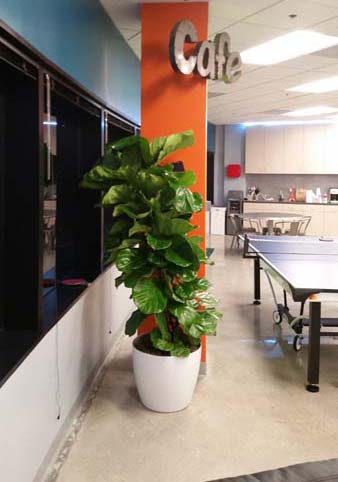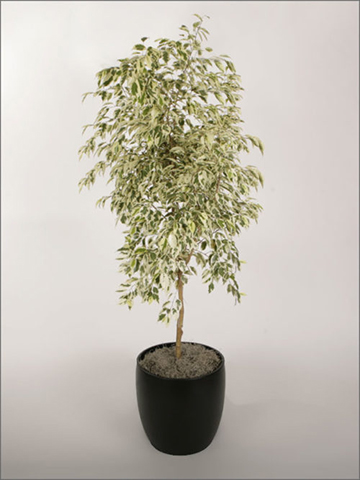Common Name: Fig tree
Light Needs
Medium to bright light
Water Requirements
Water when dry
Description:
Ficus come in all shapes and sizes, from woody trees to little vines. They are mostly evergreen trees, known for shedding leaves much like a deciduous tree during periods of drought.
Most commonly used varieties: F. benjamina; F. retusa ‘Nitida’; F. malcellandii ‘Alii’; and F. lyrata
Ficus species come in all shapes and sizes, from woody trees to little vines. They are mostly evergreen trees, known for shedding leaves much like a deciduous tree during periods of drought. F. lyrata, the monarch of all fig trees, grows to 40-feet-tall in the jungles of Africa with leaves up to 18-inches-long and pairs of one-inch figs along the stem. Ficus benjamina, part of the large Moraceae or Mulberry family, are native to Southeast Asia, India and Australia. F. Benjamina has glossy green elliptical-shaped leaves and a light tan colored trunk. Mature plants may produce small, inedible figs. Ficus Benjaminas are available in a wide variety of forms including multiple standards, braided, single trunks, bonsai, bush and corkscrew.
Medium to bright light. While Ficus species prefer strong light, they can adapt and remain alive in fairly low light (125fc) for a remarkably long period of time if water levels are kept low. Ficus varieties used in interiorscapes need to adjust to lower humidity levels and light intensities. To begin the acclimatization process, Ficus grown in direct sun are moved to shade houses for 8 to 10 weeks before they are shipped to interiorscapers. As the Ficus adjusts to the lower light levels, it drops leaves it can.
Ficus prefer to not have soggy roots and do best when the soil mix is allowed to become moderately dry between waterings. All Ficus species pout when you water them improperly. Too much will result in black spots at the leaf edges. Too little will result in the oldest leaves turning yellow and dropping. Those in good light will grow a large root mass over the years. Surprisingly, Ficus can survive in the same grow pot, with a shrinking soil mass, for many years. The only noticeable result will be less healthy looking leaves (smaller and paler). Adding fresh soil and cutting off roots outside the pot will ensure that they will start growing again.
Ficus roots need a growing media with a pH between 5.5 and 6.5, and good pore space for gas exchange and root expansion. First, keep roots healthy by watering the entire root ball thoroughly, then allowing the plant to dry out sufficiently. In medium light (100 – 200fc), allow growing media to dry down 1/3 of container; in higher light conditions allow media to dry down 2″ to 1/4″ of pot. Roots can be damaged by improper moisture levels. Underwatered plants develop symptoms such as mottled yellow leaves, leaf drop and withered stems. Meanwhile, overwatered plants drop green leaves, show signs of stunted and pale new growth, and may develop root and stem rot.
Fertilize healthy plants with a complete water soluble fertilizer during times of active growth. Do not fertilize unacclimated, stressed or infested plants. Test the growing media periodically for excess soluble salts which can damage delicate roots and interfere with water absorption. Ficus benjamina have dense, fibrous root systems that grow rapidly. Ficus grown in medium light conditions prefer to be slightly root bound, but plants in high light may need to be root pruned and repotted every 2-3 years.
Clean Ficus leaves regularly to promote healthy growth. Commercial solutions such as Leaf-Tek work well at cleaning built up grime and dust on foliage. If you prefer, you can mix up a mild solution of 1-2 tsp of dish soap and 2 tbsp of alcohol mixed in 1 quart of water. Spray until runoff and hand wipe foliage with sponges or rags. Then, gently wipe branches and trunk with soap solution and a sponge to remove dust, pests and sap.
Ficus are susceptible to scale, mealybug, spider mites, excess soluble salts, Phomopsis die back and air pollution. Control pests by pruning out small infestations, wiping individual pests with alcohol on a cotton swab or washing off pests with dish soap and water. If other IPM controls are ineffectual, apply a pesticide registered for interiorscape use that lists both the pest to be controlled and Ficus benjamina on the label. Control disease development by providing the correct environmental conditions and moisture levels for optimum growth.





